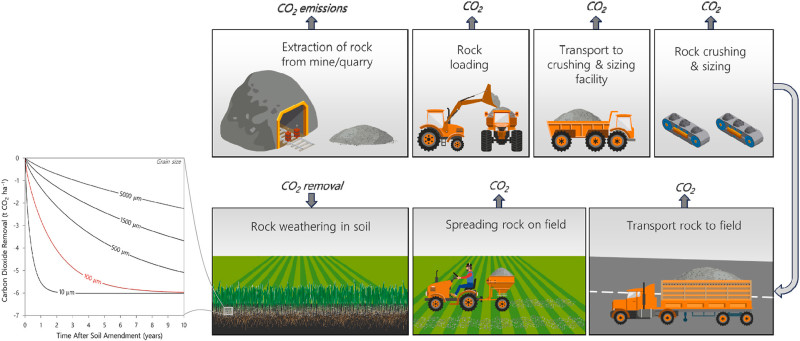Rocks could save the world (Yes, rocks) - Elise Cutts
115,770 Views
284 Questions Answered
Let’s Begin…
Mount Teide is one of the world’s largest active volcanoes, and there may be a way to use the basalt rock inside it to save humanity. Obviously, destroying an ancient volcano would cause catastrophic and unpredictable ecological fallout. But what if we harvested only some of that basalt— could it really stop climate change? Elise Cutts explores the fascinating science of enhanced rock weathering.
Create and share a new lesson based on this one.
Additional Resources for you to Explore
In the fight against climate change, scientists and policymakers are exploring various ways to remove carbon dioxide (CO₂) from the atmosphere. One promising approach gaining attention is enhanced rock weathering (ERW)—a process that accelerates the Earth's natural ability to sequester carbon through rock interactions with rainwater. This technique, while not as widely discussed as afforestation or carbon capture technologies, could play a crucial role in reducing greenhouse gas levels.
The Science Behind Enhanced Rock Weathering
Rock weathering is a natural process that occurs when rainwater, which contains dissolved CO₂, reacts with silicate minerals in rocks. This reaction forms bicarbonate, which is eventually carried to the ocean, where it can be stored for thousands to millions of years. Typically, this process happens over geological time scales, but enhanced rock weathering aims to speed it up significantly by crushing silicate-rich rocks—such as basalt—and spreading the powder over large areas, particularly agricultural fields.

Why Basalt?
Basalt, a volcanic rock found in abundance, weathers relatively quickly compared to other silicates and contains nutrients beneficial to soil health. When finely ground and spread over farmland, it reacts more rapidly with CO₂ in the atmosphere, creating a win-win situation—capturing carbon while improving soil fertility.
Potential Benefits of ERW
Carbon Sequestration – Studies suggest that large-scale application of basalt dust could sequester hundreds of gigatons of CO₂ over several decades.
Soil Health Improvement – The minerals in basalt can replenish essential nutrients, potentially reducing the need for synthetic fertilizers.
Scalability – ERW can be integrated into existing agricultural practices, making it a viable large-scale solution.
Challenges and Considerations
Despite its promise, enhanced rock weathering comes with several challenges:
Logistical and Energy Costs – Carrying, crushing, transporting, and spreading basalt globally requires significant infrastructure and energy. If fossil fuels are used in the process, it could diminish the net carbon benefit.
Environmental Concerns – Large-scale rock extraction might disrupt ecosystems, and some basalt deposits contain heavy metals that could pose risks to soil and water quality.
Uncertain Long-Term Impacts – Since ERW influences global water cycles, its large-scale effects on ecosystems are not fully understood.
Case Study: Enhanced Rock Weathering Boosts Crop Yields in Kenya
A recent pilot project conducted by Flux in Kisumu County, Kenya, has demonstrated the significant benefits of enhanced rock weathering (ERW) for both carbon sequestration and agricultural productivity. In 2024, field trials were carried out on 31 smallholder farms, where farmers applied silicate rock powder to their crops. The results were remarkable: harvests increased by an average of 71.2%, with an aggregate yield increase of 47.5% across all farms. Some plots even saw productivity jumps of 200% or higher.
For those interested in deeper exploration, key resources include:
Scientific Studies: Research from institutions like the Leverhulme Centre for Climate Change Mitigation at the University of Sheffield. You can also check out this study from the Applied Chemistry journal.
Policy Discussions: Reports from the IPCC and other climate organizations evaluating ERW’s role in global carbon reduction strategies.
As we seek solutions to mitigate climate change, enhanced rock weathering offers a compelling, nature-based approach that warrants further investigation and investment.
About TED-Ed Animations
TED-Ed Animations feature the words and ideas of educators brought to life by professional animators. Are you an educator or animator interested in creating a TED-Ed Animation? Nominate yourself here »
Meet The Creators
- Educator Elise Cutts
- Director Ivana Volda
- Narrator Susan Zimmerman
- Storyboard Artist Ivana Volda
- Animator Ivana Volda, Thomas Johnson Volda
- Art Director Ivana Volda
- Composer Stephen LaRosa
- Sound Designer Stephen LaRosa
- Director of Production Gerta Xhelo
- Produced by Sazia Afrin
- Editorial Director Alex Rosenthal
- Editorial Producer Dan Kwartler
- Fact-Checker Charles Wallace





